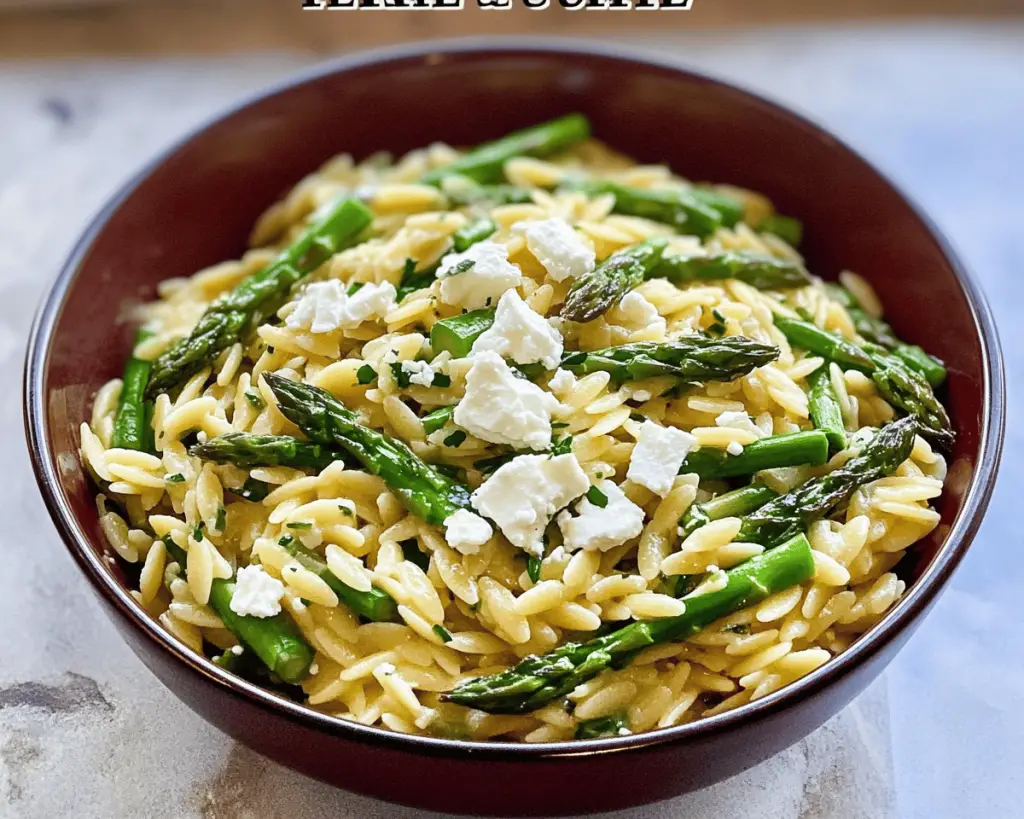As I stand in my kitchen, the warm sunlight spilling through the window and illuminating the rich greens and ivory hues of my ingredients, I’m reminded of the first time I prepared a dish that combines the tender embrace of orzo with the crisp freshness of asparagus and the creamy tang of feta cheese. It wasn’t just a meal; it was an awakening. The dance of flavors and colors brought me back to my childhood summers spent in my grandmother’s garden, where every vegetable was handpicked and every meal told a story.
Orzo, a tiny pasta shaped like grains of rice, has a way of creating a seamless blend of textures. It absorbs flavors beautifully while still offering a satisfying bite—al dente, as the Italians would say. Asparagus, bright and vibrant, lend a delightful crunch that contrasts perfectly with the creaminess of feta, which adds a saltiness that bursts through each bite. This dish is not only uncomplicated but transformative. With minimal effort, it allows one to create something that feels elegant yet grounded in the everyday.
My journey with orzo began in the modest aisles of an Italian market. I was drawn in by its invitation to be part of intricate Italian dishes as well as simpler, rustic meals. As I learned more about orzo, I realized that its versatility extends beyond traditional use. You can toss it into salads, soups, or, as I will be discussing today, prepare it as a side or light main dish that really showcases the season’s offerings.
The secret to crafting the perfect Orzo with Asparagus & Feta lies not just in the ingredients, but in the way they sing together to create a symphony on your plate—celebrating the sweet springtime harvest and the joy of sharing meals with loved ones. Each summer, as asparagus comes into season, I make it a ritual to prepare this dish, often encouraging friends and family to join me in the kitchen. It’s an experience of connection, laughter, and the simple pleasure of cooking.
Inside the Ingredients of Orzo with Asparagus & Feta
Let’s delve into the individual ingredients that make this recipe shine. Each one plays a unique role, contributing to the overall flavor and feeling of the final dish.
Orzo: This charming pasta hails from Italy, and its name translates simply to “barley.” Although it resembles rice, it is indeed a form of pasta made from durum wheat. Cooking orzo is straightforward; it behaves similarly to other pastas, needing just boiling water and salt. It offers the comforting familiarity of pasta while allowing for creative explorations of texture in dishes like this one. If you ever find yourself out of orzo, you could substitute it with other small pasta shapes like ditalini or even quinoa for a gluten-free alternative.
Asparagus: When I think of asparagus, I think of the early mornings in the local farmer’s market, greeted by the bright green spears glistening with morning dew. Asparagus is a spring vegetable and should ideally be eaten soon after picking to capture its natural sweetness. Look for firm stalks that snap easily when bent—this is a sign of freshness. For this dish, I typically opt for thin spears which tenderize nicely during cooking; however, if you prefer thicker stalks, just allow for a slightly longer cooking time.
Feta Cheese: This crumbly, tangy cheese hails from Greece and completes the dish with a burst of flavor. Its salty and sharp character pairs wonderfully with the earthiness of asparagus. I’ve learned that not all feta is created equal. My personal preference leans toward the kind packed in brine, as it retains moisture and flavor. If you want to explore variations, feel free to substitute it with goat cheese for a creamier texture, or even a sharp cheddar for a different flavor profile.
Olive Oil: Extra virgin olive oil is essential in this recipe—not just for sautéing but also for enhancing the richness of the ingredients. There’s nothing quite like the aroma of olive oil heating in a pan, reminding me of countless dishes I’ve created centered on fresh produce. Always opt for high-quality extra virgin olive oil; it can elevate even the simplest of recipes.
Garlic: Fresh garlic brings warmth and depth to the dish. There’s something so comforting about the scent of garlic sizzling in olive oil. I often crush my garlic cloves to release their fragrant oils, but dicing or slicing works just as well if you prefer a subtler flavor. Don’t be afraid to adjust the quantity; if you’re a garlic lover like me, go ahead and add a little extra!
Salt and Pepper: The timeless duo of salt and pepper is fundamental to bringing out the flavors of each ingredient. Always remember that seasoning is personal. I tend to be generous with fresh ground black pepper, as it contributes an earthy spice that balances with the creaminess of the feta beautifully.
Lemon Juice and Zest: Fresh citrus adds brightness and acidity, lifting the dish and harmonizing the flavors. The zest of a lemon infuses a vibrant note, while the juice ties everything together seamlessly. Lemon can transform a dish; it’s like an artist adding the finishing touches to their masterpiece.
How Orzo with Asparagus & Feta Fits Into a Balanced Life
While this Orzo with Asparagus & Feta is undeniably indulgent, it provides well-rounded nutritional benefits that make it a delightful part of a balanced diet.
The base of orzo, made from durum wheat, provides carbohydrates—an essential source of energy. It also contains small amounts of protein, assisting in muscle recovery and satiety. The presence of asparagus brings a wealth of vitamins—most notably Vitamin K, which is crucial for bone health, and Vitamin A, which supports vision and immune function. Asparagus is also rich in folate, aiding in cell division and overall health.
Feta cheese, while heavier in sodium, offers calcium and protein. Those on a lower-sodium diet should be cautious when adding salt to the dish, but one can moderate this by using crumbled feta sparingly. The olive oil encourages healthy fats, contributing to heart health while also enhancing the dish’s richness.
I find that balance in my cooking comes from being mindful of portion sizes and paying attention to how my meals make me feel. This dish is an excellent example of how we can eat and still feel satisfied without overwhelming our systems. Pairing it with a green salad can also round out the meal, providing additional fiber and nutrients. I love to serve it with a light vinegarette, completing the meal with contrasting flavors.
What You’ll Need
– 1 cup of orzo
– 2 tablespoons of extra virgin olive oil
– 1 bunch of asparagus (about 1 pound), trimmed and cut into 1-inch pieces
– 2 cloves of fresh garlic, minced
– 1/2 cup of crumbled feta cheese
– Juice and zest of 1 lemon
– Salt and freshly ground black pepper to taste
– Optional: Fresh herbs (like parsley or dill) for garnish
This recipe serves approximately 4 as a side dish or 2 as a main course.
Preparing Orzo with Asparagus & Feta Step by Step
Step 1: Bring a large pot of salted water to a boil, and add the orzo. Cook according to package instructions, usually about 8-10 minutes, until al dente. Watch carefully, as overcooking can lead to mushy pasta. Once it’s ready, drain it and set aside, but do not rinse; you want to retain some of the starch to help the sauce adhere.
Step 2: While the orzo is cooking, heat the olive oil over medium heat in a large skillet. The warmth should bring out the nutty aroma of the oil. Add the minced garlic and sauté for about 30 seconds until fragrant, being careful not to burn it.
Step 3: As the garlic begins to sizzle invitingly, toss in the cut asparagus. Sauté for about 5-7 minutes, stirring occasionally. The asparagus should turn bright green and remain crisp-tender. If the skillet feels dry, you can splash in a little more olive oil or even a dash of water to help the cooking process while maintaining a vibrant green color.
Step 4: Once the asparagus is cooked to your liking, add the drained orzo to the skillet. Season generously with salt and pepper. Gently toss everything together, allowing the flavors to meld while warming the pasta evenly.
Step 5: Remove the skillet from the heat and stir in the crumbled feta cheese, lemon juice, and lemon zest. The residual heat will soften the feta without melting it completely—ensuring that every bite is infused with those creamy, tangy notes.
Step 6: Taste and adjust the seasoning as needed before transferring the dish to a serving bowl or plate. If you’re feeling inspired, a sprinkle of freshly chopped herbs can elevate the presentation and flavor, bringing another layer of freshness.
Step 7: Enjoy! I always love to dive into this dish warm, when the flavors are at their peak.
Lessons from My Kitchen
Reflecting on the many times I’ve prepared Orzo with Asparagus & Feta reminds me not just of the joy it brings, but also of the lessons I’ve learned through practice. Cooking is an art form filled with moments of triumph and whispering failures; every experience teaches us something valuable.
One particular time, I decided to experiment with roasted asparagus instead of sautéing it—not anticipating the additional cooking time would affect the dish’s overall texture. The flavor was still there, albeit the asparagus didn’t play its signature role and became more of a muted background note. This was a pivotal learning moment for me, reminding me that while improvisation in the kitchen is exciting, understanding how each element can contribute to the final product is essential.
Another lesson I pick up over time is to celebrate seasonality. A recipe like this can evolve with the change of seasons. In fall, consider adding roasted butternut squash or sautéed mushrooms alongside the asparagus for depth and warmth. The bright, fresh flavors of parsley or dill can bring summer forward, while toasted nuts (like pine nuts or walnuts) can add richness and crunch, elevating the dish even further.
In fact, for those cozy winter evenings, I am known to add some cooked spinach or kale for a heartier texture, extending its nutritional heft while keeping things interesting.
And let’s not forget, the joy of cooking is truly amplified when shared. I encourage you to invite friends or family into your kitchen for this dish—it may just ignite a profound love for cooking in their hearts as well.
As I wrap up this exploration of Orzo with Asparagus & Feta, I invite you to consider how meals shape our narratives. Each flavor we experience and every dish we create builds upon the essence of our shared histories—the rituals of cooking, the celebrations of gatherings, and the comforting moments spent alone. As you replicate this recipe in your kitchen, may it become a canvas for your own culinary stories, shared laughter, and treasured memories.
There’s a richness in the act of preparing food—a beauty that transcends the meal itself. May you find joy in every step of the journey, from the chopping of asparagus to the final sprinkle of feta, allowing the love of cooking to fill your heart and home.



